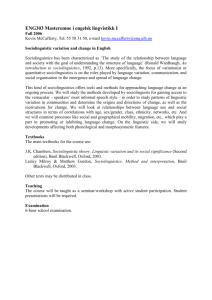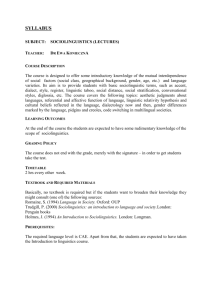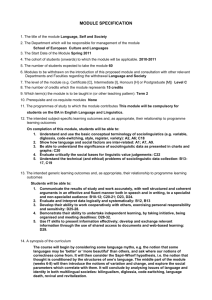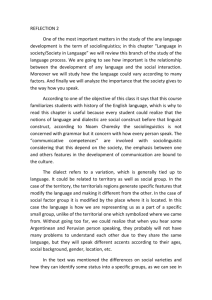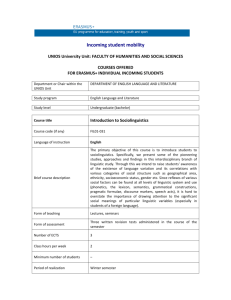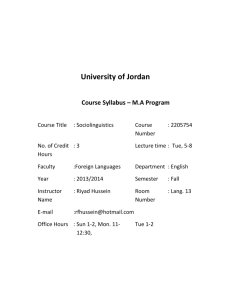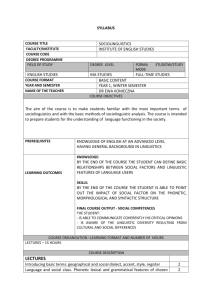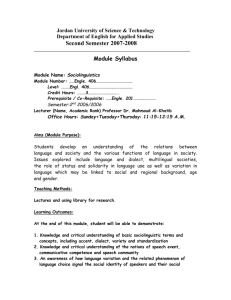Course Objectives
advertisement
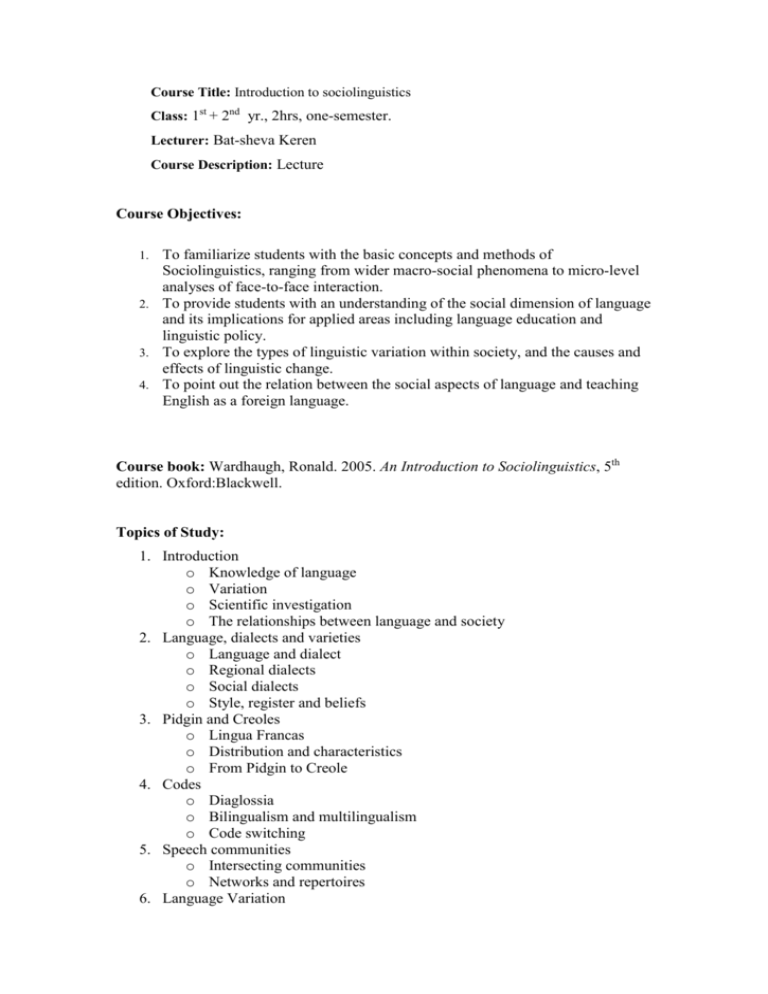
Course Title: Introduction to sociolinguistics Class: 1st + 2nd yr., 2hrs, one-semester. Lecturer: Bat-sheva Keren Course Description: Lecture Course Objectives: To familiarize students with the basic concepts and methods of Sociolinguistics, ranging from wider macro-social phenomena to micro-level analyses of face-to-face interaction. 2. To provide students with an understanding of the social dimension of language and its implications for applied areas including language education and linguistic policy. 3. To explore the types of linguistic variation within society, and the causes and effects of linguistic change. 4. To point out the relation between the social aspects of language and teaching English as a foreign language. 1. Course book: Wardhaugh, Ronald. 2005. An Introduction to Sociolinguistics, 5th edition. Oxford:Blackwell. Topics of Study: 1. Introduction o Knowledge of language o Variation o Scientific investigation o The relationships between language and society 2. Language, dialects and varieties o Language and dialect o Regional dialects o Social dialects o Style, register and beliefs 3. Pidgin and Creoles o Lingua Francas o Distribution and characteristics o From Pidgin to Creole 4. Codes o Diaglossia o Bilingualism and multilingualism o Code switching 5. Speech communities o Intersecting communities o Networks and repertoires 6. Language Variation o Regional variation o The linguistic variable o Linguistic and social variation o Data collection and analysis 7. Language change o The traditional view of language change o Change in progress o The process of change 8. Language and culture o The Sapir-Whorf hypothesis o Taxonomies (categorization) o Color o Taboo and Euphemisms 9. Solidarity and politeness o Tu vs. Vous o Address terms o Politeness (Brown & Levinson, Lakoff) 10. Talk and action o Speech acts (Searl) o The Cooperation Principle (Grice) 11. Understanding and intervening o Language and gender o Differences between genders o Possible explanations 12. Language and disadvantage o The importance of code o African American Vernacular English o Consequences of education 13. Language planning. Assessment: 1. Final exam – 70% 2. Reading and home assignments – 25% 3. Class participation – 5% Bibliography: Brown, P. and Levinson, S.C. (1987) Politeness: some universals in language use. Cambridge: Cambridge University Press. Coulmas. F. (ed.). (2000) The Handbook of Sociolinguistics. Oxford: Blackwell. Coupland, N and Jaworski, J. (eds.) (1997) Sociolinguistics: A Reader and Coursebook. Basingstoke, Hants: Macmillan Fasold, R. (1990) The Sociolinguistics of Language. Oxford: Blackwell Fasold, R. (1984) The Sociolinguistics of Society. Oxford: Blackwell. Holmes, J. (2000) An Introduction to Sociolinguistics. London: Longman. Hudson, R.A. (1996) Sociolinguistics. Cambridge: Cambridge University Press. Labov, W. (1972) Sociolinguistic Patterns. Oxford: Blackwell Milroy, L. and Gordon, M. (2003) Sociolinguistics: Method and Interpretation. Oxford: Blackwell. Pride, J.B. and Holmes, J. (eds.) (1972) Sociolinguistics. Harmondsworth: Penguin. Romaine, S. (1994) Language in Society: An Introduction to Sociolinguistics. Oxford: Oxford University Press. Trudgill, P. (2000) Sociolinguistics: An Introduction to Language and Society. London: Penguin. Wardhaugh, R. (2005) An introduction to Sociolinguistics. Oxford: Blackwell. Contact: Tel. 02 970 9873, 054 7741570 e-mail: bat7keren@gmail.com

